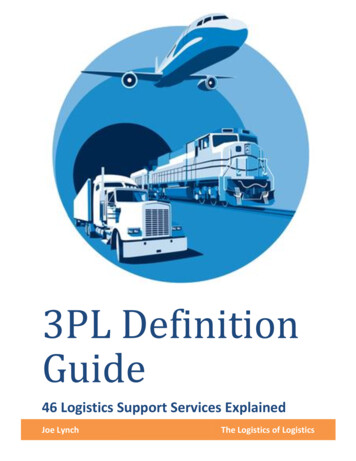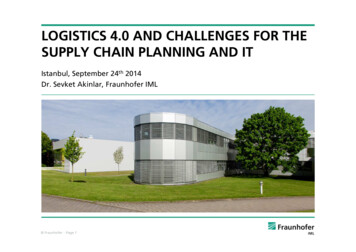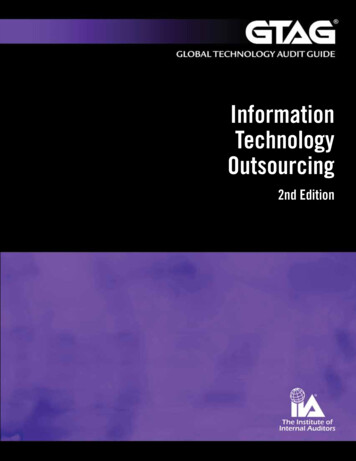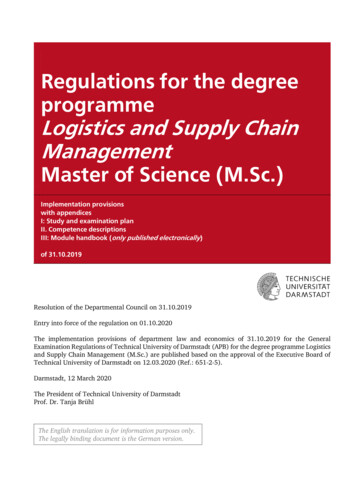
Transcription
Logistics Outsourcing and 3PL ChallengesMichelle L.F. CheongSingapore-MIT Alliance, N2-B2C-15, Nanyang Technological University, 50, Nanyang Ave,Singapore 639798Abstract — Logistics has been an important part of everyeconomy and every business entity. The worldwide trend inglobalization has led to many companies outsourcing theirlogistics function to Third-Party Logistics (3PL) companies,so as to focus on their core competencies. This paper attemptsto broadly identify and categorize the challenges faced by 3PLcompanies and discover potential gaps for future research.Some of the challenges will be related with the experience andinformation collected from interviews with two 3PLcompanies.provider sits in the middle between the manufacturers orsuppliers (the buyers of the 3PL service, known asshippers) and the end customers (the consumers of theproducts). In this position, the 3PL provider will need tobalance the dynamic pulls generated by the upstream anddownstream entities, and thus faces challenges which areunique to its operations.Index Terms — Logistics, Outsourcing, Third-partyLogistics, ChallengesI. INTRODUCTIONLOGISTICS has been an important part of everyeconomy and every business entity. Logistics costaverage about 12% of the World’s GDP [1]. In Singapore,logistics cost accounts for about 11% of its GDP [2]. Theworldwide trend in globalization has led many companiesto outsource their logistics function to Third PartyLogistics (3PL) companies, so as to focus on their corecompetencies. In a recent study [3] conducted by CapGemini Ernst & Young US LLC, Georgia Tech and Fedex,involving 400 representatives from North America,Western Europe and Asia Pacific, it is concluded thatlogistics outsourcing remains a growing business globally.On a smaller scale, Bhatnagar, Sohal and Millen [4]reported that the need for logistics outsourcing is alsoincreasing in Singapore.The overall trend in logistics outsourcing is moving intwo directions: (1) increase in the number of buyers oflogistics services, and (2) increase in the extent of usage oflogistics services. The extent of usage includes number ofactivities or business process outsourced, geographicalcoverage, nature and length of contract, percentage of totallogistics budget allocated to 3PL companies and level ofcommitment [4].In a typical 3PL arrangement (see Fig. 1), the 3PLManuscript received 3rd November 2003.M.L.F. Cheong is a PhD student with the Singapore-MIT Alliance(SMA) under the Innovations in Manufacturing Systems and Technology(IMST) program hosted at Nanyang Technological University, Singapore.(email:ps7034700h@ntu.edu.sg).Fig. 1. Typical 3PL arrangementWith the positive outlook for the 3PL business and theimmense competition which is likely to follow, it is criticalthat 3PL companies recognize that low price is not longer asure-win strategy. In a study by Sink, Langley and Gibson[5], it was found that the most important selection criterionfor 3PL provider was core competencies. Thus, theobjective of this paper is to help 3PL companies identifyand categorize the challenges in the business in a broadsense, and to discover potential gaps where research anddevelopment can help bridge the gap. The rest of this paperis organized as follows. In the next section, importantsegments of literature on logistics outsourcing arereviewed. Subsequently, the broad categorization of 3PLchallenges is described, followed by detailed discussionand potential gaps identification. Some of the challengeswill be related to the interviews conducted with two 3PLcompanies. Finally, the list of future research directions isgiven at the end.II. LITERATURE REVIEWThere are many papers on logistics outsourcing andRazzaque and Chang [6] did a comprehensive review on
the outsourcing of the logistics function. In general, thisliterature can be generally categorized according todifferent focus area. Some of these focus areas includelogistics practices, usage of 3PL logistics services, currentstate and future trends, strategies and performancemeasurements. Interested readers can be referred to thefollowing papers (not meant to be exhaustive) in each ofthe focus area, Logistics practices – Bardi and Tracey [7], McMullan[8], Millen and Sohal [9], Rao, Young and Novick[10] Usage of logistics services – Lieb [11], Lieb, Millenand Wassenhove [12], Lieb and Randall [13], Dapiran,Lieb, Millen and Sohal [14], Bhatnagar, Sohal andMillen [4] Current state and future trends – Kim [15], Gilmour,Driva and Hunt [16], Sheffi [17], Peters, Cooper, Lieband Randall [18] Strategies – Ballou [19], Copper [20], Sum and Teo[21], LaLonde and Masters [22] Performance measurements – Pools van Amstel andD’Hert [23], van Hoek [24], van Heok [25], Chow,Heaver and Henriksson [26]On the other hand, there are not many papers which lookat the challenges faced by 3PL companies and address howthey can overcome such challenges. One paper by Min [27]listed some of the challenges related to distribution but isspecifically for the Japan market. Some of the listedchallenges include overcoming the dominance ofwholesalers, understanding the complex structure of thedistribution channel and legal issues. This paper however,attempts to identify and categorize the challenges faced by3PL companies on a higher level and in a broader sense.The challenges identified are grouped into different layers.In each layer, the associated attributes are listed andpotential gaps are identified. Some of the challenges arelinked to the experience and information collected from theinterviews with two 3PL companies.requirements at the minimum cost. The optimal networkconsists of, Optimal number of warehouses and distributioncenters (DCs) Location of these warehouses and DCs Service areas of each warehouse and DC Routings of the goods (e.g. direct shipping or viaconsolidation) Type and amount of inventory to be stored at eachlocation Allocation of production plants to warehouses andDCsThe interested readers can be referred to Cooper [28],Balakrishnan, Magnanti and Wong [29], and Nozick [30]for a review of location problems.Material flow refers to the movement of products fromthe upstream entities, via the 3PL provider, to thedownstream entities. Major concerns in material flowinclude, Scheduling of transportation to pick up the productsfrom the manufacturers and deliver the products to thecustomers. Warehousing of the products at the 3PL hubs and DCs Consolidation of products Monitoring the inventory levelsSome of the papers which address such issues include,Tyan, Wang and Du [31], Xu, Chen, Rajagopal andArunapuram [32], and Yokoyama [33].Information flow refers to the flow of informationthroughout the supply chain. Information flow usuallyaccompanies the material flow, and both are tightlycoupled together. Important information includes orderinformation, inventory data, product types, origin anddestination, etc.The final layer, the relationshipmanagement is concerned with the necessary terms andconditions which facilitate the partnership between the 3PLprovider and its client.III. LAYERS OF 3PL CHALLENGESLogistics planning attempts to make decision at threedifferent levels, namely strategic, tactical and operational.These three levels are differentiated by their planninghorizon, where strategic level is in years, tactical level inmonths, and operational level in weeks and days. Here, the3PL challenges are differentiated by their level oftangibility as shown in Fig. 2. At the top level is theLogistics Network Configuration layer (most tangible), toMaterial Flow layer, to Information Flow layer, and finallyto Relationship Management layer (least tangible).Logistics network configuration is concerned withdesigning the optimal network to satisfy serviceFig. 2. Layers of challenges faced by 3PL companiesFor each of these layers, some of their associatedattributes are listed as shown in Fig.3. Logistics Network Configuration – location, links,warehouse sizing, allocation, customer points Material Flow – inventory, scheduling, lot sizing,
warehousing, consolidating Information Flow – order processing, informationsharing, IT systems integration, Internet and visibility Relationship Management – performance measuresand contract designFor the discussion in the next few sections, some of theattributes will be discussed in detail as we move from layerto layer.Fig. 3. Associated attributes for each layerIV. LOGISTICS NETWORK CONFIGURATION3PL companies which take over the logistics functionfrom their clients usually have to set up a logistics networkto support the flow of products from the client’smanufacturing plant to the end customers. This is done bybuilding warehouses and DCs at locations required by theirclients. 3PL companies are always in need of logisticsnetwork configuration solution models to help them designthe best logistics network to operate at minimum cost whilesatisfying service requirements.Logistics network configuration is usually tackled aslocation problem in the academic arena. Brandeau andChiu [34] have provided a comprehensive overview ofrepresentative problems in location research. Theycategorized location research according to objective,decision variables and system parameters. In all, a total of54 types of different location problems were identified.sup-optimal under tomorrow’s conditions. There have beenstudies which looked at dynamic network configuration.They include work from Ballou [35], Sweeney and Tatham[36], Wesolowsky and Truscott [37], Van Roy andErlenkotter [38]. All these works addressed the problem bydynamically changing the warehouse locations in responseto changes in requirements, and typically trade-off thesavings achieved with the costs in implementing thechange.From the interview with a large 3PL company whichserves an international PC maker to distribute PCs from themanufacturing plants to the customers, such a solutionbased on dynamic warehouse location is not suitable. 3PLcompanies seek long-term relationship with their clientsand usually build warehouses to exploit lower costs ascompared to leasing from public warehouses. As the 3PLbusiness grows, the number of warehouses and DCs willbecome saturated, and can no longer afford to build moresimply to cater to changes, while leaving existingwarehouses underutilized.A more desirable solution would be to dynamicallychange other attributes which are not as physical aswarehouses. In other words, a better solution method isrequired to dynamically change one, some or all of thefollowing, The assignment of customer points to warehouses The assignment of plants to warehouses Transportation links and modes Warehouse capacity allocationThe trade-off considered can be similar to previousresearch works on dynamic warehouse location, that is, totrade-off savings achieved with the costs in implementingthe change. In addition, since this is a dynamic model, thesolution should also recommend the optimal point in timeto implement the required changes.V. MATERIAL FLOWOne important thing to note in all the solution models isthis – the logistics network design solutions are generatedbased on static information, such as, Customer locations and demand by product Potential warehouse locations, size and costs Available transportation links and costs Plant locations and capacity Service level requirementsHowever, the real world is never static. Supply chainrequirements keep changing. Customer demand can changein spatial and temporal terms. Manufacturer requirementscan change due to product changes. Implementing anetwork configuration based on today’s data will becomeProblems related to material flow are always faced by3PL companies. These problems can be related toinventory policy, scheduling of fleet, routing of vehicles,consolidation and warehousing. Many of such materialflow challenges can be tackled better using coordinationtechniques. From the interview with an internationallyknown 3PL company, which serves an automobile makerto distribute its automobile spare parts received mainlyfrom US and Germany, to twenty-six countries aroundAsia-Pacific, coordination can be used to overcome thevariability introduced by the long delivery lead time, anddynamism from upstream and downstream.Exactly how much coordination is possible from the 3PL
provider’s stand point? From Fig. 4, we can see that withinthe company, the 3PL provider can coordinate its inboundlogistics with warehousing and also with outboundlogistics. Inter-company coordination can also be possible.Examples would include, Coordination among 3PL companies which formalliances Coordination with upstream manufacturer/supplier tosynchronize production schedule with inboundtransportation schedule Coordination with downstream customers/retailers tosynchronize inventory level with outboundtransportation scheduleHowever, the biggest barrier in inter-companycoordination is in information sharing and the issue oftrust. Many research works have been done in informationsharing (to be discussed in section VI) which shows thatcompanies which collaborate and share information reapedtremendous amounts of benefits.Fig. 4. Possible coordination opportunities for 3PLproviderIn coordinating production with transportation schedules,research works by Maxwell and Muckstadt [39],Blumenfeld, Burns, Diltz and Daganzo [40], Blumenfeld,Burns and Daganzo [41], Hahm and Yano [42-45] and therecent work by Khouja [46], all considered suchcoordination from the standpoint of the supplier of theproducts, delivering products to end customers themselves.These works can be categorized according to the followingparameters, Number of origins versus number of destinations Number of item types produced at the origins versusnumber of item types delivered at the destinations Direct shipping or via consolidation Synchronization possible or not possible Accumulation of inventory before delivery consideredor not considered Common cycle or nested cycle Product cycling or economic lot sizing Setup cost and setup time considered or not considered Freight charge is per trip or per truck Fixed or variable production rateAt the other end of the supply chain, the 3PL providercan also coordinate the transportation schedule of itsoutbound logistics with the inventory levels at the retailers.This is similar to Vendor Managed Inventory (VMI) orContinuous Replenishment Program (CRP), except that the3PL provider acts on behalf of the supplier. Again, themain success factor in VMI is in sharing of information,including sharing of point-of-sales data and inventory levelinformation. Papers on VMI include Raghunathan andYeh [47] which studied the impact of information sharingon CRP and factors that affect the value of CRP, and alsoquantified the value of CRP and determined the optimalnumber of retailers a manufacturer should work with; K.L.Cheung and H.L. Lee [48] which focused on usinginformation to coordinate shipment to achieve economiesof scale and to use information for stock rebalancing, andalso compares the benefits derived from both; Cetinkayaand Lee [49] which presented an analytical model toapproximate the optimum replenishment quantity anddispatch frequency simultaneously; Axsater [50] inresponse to [49] provided a simple procedure to computeexactly and illustrated that the errors when using the modelin [49] can be very large for certain problem types.To achieve a total coordination of upstream anddownstream entities, a 3PL provider can attempt to mergethe solution methods from synchronization of productionand transportation schedules and VMI. The main benefitwould come from the 3PL provider’s ability to risk poolinventory at its hub, and schedule pick up and deliveryaccording to dynamic changes upstream and downstream.VI. INFORMATION FLOWInformation is one of the most important elements inlogistics management. Previous research works oninformation sharing include (1) works that look at thevalue of information sharing, (2) works that look atcollaborative forecasting and (3) works that developreplenishment policies based on information sharing,. Forthe last case, it has been discussed as VMI in the earliersection.For the first case, works include, Lee, So and Tang [51]which developed an analytical model fore one retailer andone manufacturer, to quantify the benefit of informationsharing and found that the benefit is very high especiallyfor demands that are significantly correlated over time andwhen demand variance is high and also for the case of longlead times; Cachon and Fisher [52] compared the reductionin supply chain costs between a supply chain that does notshare information with one that shares full information, fora model with one supplier and N identical retailers withstationary stochastic demand. The result from thenumerical study showed a 2.2% lower on the average and amaximum of 12.1%; Gavirneni, Kapuscinski and Tayur[53] studied the role of information under three settings:
(1) supplier has no information except past data, (2)supplier knows the demand distribution and that the retaileruses (s,S) policy and (3) supplier has full information, for atwo-stage capacitated supply chain. They showed theoptimality of order-up-to policies for finite and infinitehorizon, and through computational analysis, quantified thesavings obtained;For the second case on sharing information forcollaborative forecasting, known as collaborative planning,forecasting and replenishment (CPRF), usually involvestwo parties, the manufacturer and the retailer. Thecollaborating parties would jointly generate a forecast andplan for that forecast. The desired effect would be to makethe supply chain more efficient since the forecast iscoordinated and carried more information. Yossi [54]studied a two-stage supply chain involving a supplier and aretailer. He created two models, (1) a decentralizedstructure where each member performs local forecastingand integrates adjusted forecasts into his replenishmentprocess and (2) a centralized structure where the twomembers jointly forecast and update, and compared thetwo models with a benchmark model where forecasts arenot integrated with the replenishment process. In thefollowing year, Yossi [55] studied the case of autocorrelated demand on the same two-stage supply chain. Hecreated three models, (1) retailer and supplier coordinatetheir policy parameters but do not share observations, (2)supplier manages the supply chain’s inventory withoutinformation of retailer’s observations, and (3) full sharingof observations with collaborative forecasting. The insightderived was, VMI and CPRF becomes more important asthe demand process is more correlated across time, and ascompany’s ability to explain the demand uncertaintythrough early demand information improves.From 3PL provider’s standpoint, having early demandinformation and be part of the collaborative forecastingeffort, will definitely help in planning the transportationcapacity, inventory levels, and scheduling. Consider thebusiness conditions of the 3PL company which serves theautomobile maker. Automobile spare parts are shipped toservice centers as regular parts required during regularservice schedules and as emergency parts due to caraccidents. These spare parts are usually very expensivewhich suggests low inventory and when needed inemergency must be shipped by air. The company faces thedifficulty in managing the inventory of the spare parts tocater for both regular orders and emergency requests whichmust be satisfied immediately. Having constantly updateddemand information and forecast, the company will be ableto handle the inventory and transportation planning andscheduling more efficiently.Other than sharing information for coordination (asdiscussed in section VI) and forecasting, the other vitalbenefit for a 3PL provider is achieving visibility. In arecent report [56] submitted by Cap Gemini Ernst andYoung, Georgia Southern University and the University ofTennessee, it was reported that visibility in the supplychain should be the first of the six drivers (includingconnectivity, execution, optimization, collaboration andspeed) to be implemented. From this report, it is concludedthat visibility can result in the following benefits, Creating an adaptive supply chain that is effective andefficient Increasing the ability to do demand-drivenreplenishment (as in VMI) Lowering inventory levels Reducing cycle times Improving the use of more cost-effectivetransportation3PL companies usually share order tracking informationover the Internet to allow their clients to have visibility oftheir products within the supply chain. However, there hasbeen very little research work which focuses on how the3PL companies can participate more actively ininformation sharing, what other types of information canbe shared, using what kind of technologies, the subsequentimpacts, as well as assessing the value the 3PL companyachieve through information sharing.In logistics management, information systems are partand-parcel of the business. Some of the informationsystems used are Logistics Information System ion Management System (TMS). In a recentpaper by Mason, Ribera, Farris and Kirk [57], they claimedthat “Companies are not suitably equipped to makeinformed, effective decisions based on the data collectedseparately by WMS and TMS ”, and “Today’ssupply chain management systems must not only be able toprovide real-time data but also to integrate data across thesupply chain and to support real-time decision making inresponse to changing conditions.” They addressed some ofthe open questions pertaining to the integration of WMSand TMS, and highlighted the potential benefits of theintegration. Also, simulation analysis was used to examinethe benefits gained. To benefit the 3PL companies, moreresearch work can be done in this area to address thechallenges which are unique being the middle man in thesupply chain.VII. RELATIONSHIP MANAGEMENT3PL companies usually seek long-term relationship withtheir clients and thus are very concerned with maintaininggood relationship through good performance. Performancemeasures are used to gauge whether the 3PL provider hasprovided its services up to, above or below the expected
level. Some of the performance measures given in [8] are, Inventory accuracy On-time shipments Customer complaints Backorders Warehouse cycle time Number of kilos/unit shipped Number of dollars shippedFor large 3PL partnerships, performance measures areusually linked to the legal contract between the 3PLprovider and its client, to determine the performanceincentives and non-performance penalties. In any of suchcontracts, it is important that the associated penalties andincentives stated are fair for both parties involved. In thepaper by Lim [58], he proposed a game-theoretical modelto find an optimal contract, which includes penalty andgain-sharing incentives, which will be accepted by the 3PLprovider and induce the 3PL provider to truthfully revealhis capability. However, from the list of performancemeasures given above, it is obvious that the performancemeasures are rather numeric in nature and does not directlyrelate to the true bottom line, dollars and cents. How thencan the penalties and incentives be valued if theperformance measures are not measured in dollars andcents?Again, consider the 3PL company which serves theautomobile maker. Part shortages sometimes occur at theservice centers, resulting in car owners unable to have thefaulty part replaced in the car on time. This sometimes leadto car owners replacing the faulty part using alternative ornon-genuine parts which may affect the overallperformance of the car, which in turn affects the overallimage of the car brand. In other situation, the unsatisfiedcar owner may just change the car to another brand, thusthe car maker ends up losing an existing customer. Thisdiscussion may seem hypothetical but in fact is very real.By quantifying the actual money loss accrued due to a unitof a particular non-performing indicator, it will allow the3PL provider to prioritize its operations towards fulfillingthe more high-valued ones. Also, the penalties andincentives can then be related to a parameter of the sameunits.VIII. FUTURE RESEARCHThe objective of this paper is to provide a broadcategorization of the challenges of 3PL companies andidentifying the potential gaps. The potential gaps in each ofthe layers are summarized in the table below,1LayerLogisticsNetworkPotential GapsDynamiclogisticsnetworkconfiguration with changes inConfiguration2Material rtation links and modes,assignment of warehouses todemand points, assignment ofplants to warehouses, allocation ofwarehousecapacity,whilekeeping the location and size ofexisting warehouses fixed. Coordination with upstreamto coordinate production andinbound transportation Coordinationwithdownstream retailers tocoordinate inventory levelwith outbound transportation Fullcoordinationwithupstream and downstream Study information sharingfor collaborative forecastingfrom3PLprovider’sstandpoint. Explore ways for 3PLcompaniestoshareinformation, address thetypes of information to beshared, types of technologyto use, assess the impact andvalue in sharing information. Integration of LIS, WMSand TMS.Quantifying the actual money lossaccrued due to a unit of nonperforming indicator.This list of potential gaps is useful for academicpractitioners to perform future research to develop solutionmethods to answer the needs of 3PL companies.ACKNOWLEDGMENTThe author wishes to thank Professor R. Bhatnagar fromNanyang Business School, NTU, and Professor S.C.Graves from Sloan School of Management, MIT, for theirvaluable advice and suggestions. Also, sincere thanks go tothe two anonymous 3PL companies who provided theirthoughts and shared their business practices and needs.REFERENCES[1][2][3][4]R.H. Ballou, Business Logistics Management, 4th ed., Prentice Hall,1999, pp. 12.Press release, Opening address by Peter Chen, Senior Minister ofState for Trade & Industry and Education at the opening ceremonyof the LEAP program, Sep. 2001.Council of Logistics Management’s (CLM) 2003 Annual Report,Illinois US, Sep. 2003.R. Bhatnagar, A.S. Sohal and R. Millen, “Third party logisticsservices: a Singapore perspective,” International Journal of PhysicalDistribution & Logistics Management, vol. 29 No. 9, pp. 569–587,1999.
[5]H.L. Sink, C.J. Langley Jr. and B.J. Gibson, “Buyer observations ofthe US third-party logistics market,” International Journal ofPhysical Distribution & Logistics Management, vol. 26 No. 3, pp.38–46, 1996.[6] M.A. Razzaque and C.C. Chang, “Outsourcing of logisticsfunctions: a literature review,” International Journal of PhysicalDistribution & Logistics Management, vol. 28 No. 2, pp. 89–107,1998.[7] E.J. Bardi and M. Tracey, “Transportation outsourcing: a survey ofUS practices,” International Journal of Physical Distribution &Logistics Management, vol. 21, no. 3, pp. 15–21, 1991.[8] A. McMullan, “Supply chain management practices in Asia Pacifictoday,” International Journal of Physical Distribution & LogisticsManagement, vol. 26, no. 10, pp. 79-95, 1996.[9] R. Millen and A. Sohal, “Current logistics practices in the AsiaPacific region,” International Journal of Physical Distribution &Logistics Management, vol. 26, no. 10, 1996.[10] K. Rao, R.R. Young and J.A. Novick, “Third-party services in thelogistics of global firms,” Logistics and Transportation Review, vol.29, no. 4, pp. 363–370, 1993.[11] R.C. Lieb, “The use of third party logistics services by largeAmerican manufacturers,” Journal of Business Logistics, vol. 13, no.2, pp. 29–42, 1992.[12] R.C. Lieb, R.A. Millen and L.N.V. Wassenhove, “Third-partylogistics services: a comparison of experienced American andEuropean manufacturers,” International Journal of PhysicalDistribution & Logistics Management, vol. 23, no. 6, pp. 35–44,1993.[13] R.C. Lieb and H.L. Randall, “A comparison of the use of third partylogistics services by large American manufacturers, 1991, 1994 and1995,” Journal of Business Logistics, vol. 17, no. 1, pp. 305–320,1996.[14] P. Dapiran, R. Lieb, R. Millen and A. Sohal, “Third party logisticsservices usage by large Australian firms,” International Journal ofPhysical Distribution & Logistics Management, vol. 26, no. 10, pp.36–45, 1996.[15] J.I. Kim, “Logistics in Korea: current state and future directions,”International Journal of Physical Distribution & LogisticsManagement, vol. 26, no. 10, pp. 6–21, 1996.[16] P. Gilmour, H. Driva and R.A. Hunt, “Future directions in logisticsin Australia,” International Journal of Physical Distribution &Logistics Management, vol. 25, no. 3, pp. 24–32, 1994.[17] Y. Sheffi, “Third party logistics: present and future prospects,”Journal of Business Logistics, vol. 11, no. 2, pp. 27–39, 1990.[18] M. Peters, J. Cooper, R.C. Lieb and H.L. Randall, “The third-partylogistics industry in Europe: provider perspectives on the industry’scurrent status and future prospects,” International Journal ofLogistics: Research and Applications, vol. 1, no. 1, pp. 9–26, 1998.[19] R.H. Ballou, “Reformulating a logistics strategy,” InternationalJournal of Physical Distribution & Logistics Management, vol. 23,no. 5, pp. 30–38, 1993.[20] J.C. Cooper, “Logistics strategies for global businesses,”International Journal of Physical Distribution & LogisticsManagement, vol. 23, no. 4, pp. 12–23, 1993.[21] C.C. Sum and C.B. Teo, “Strategic posture of logistics serviceproviders in Singapore,” International Journal of PhysicalDistribution & Logistics Management, vol. 29, no. 9, pp. 588–605,1999.[22] B.J. LaLonde and J.M. Masters, “Emerging logistics strategies:blueprints for the next century,” International Journal of PhysicalDistribution & Logistics Management, vol. 24, no. 7, pp. 35–47,1994.[23] R.P. Pools van Amstel and G.
Gemini Ernst & Young US LLC, Georgia Tech and Fedex, involving 400 representatives from North America, Western Europe and Asia Pacific, it is concluded that logistics outsourcing remains a growing business globally. On a smaller scale, Bhatnagar, Sohal and Millen [4] reported that the need for logistics outsourcing is also increasing in Singapore.










